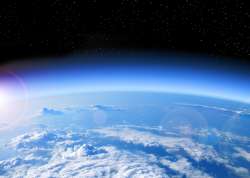Scientists shocked at mysterious source of Ozone-destroying banned chemical CFC-11
A new analysis of long-term atmospheric measurements by NOAA scientists shows emissions of the chemical CFC-11 are rising again, most likely from new, unreported production from an unidentified source in East Asia.

The scientists have detected a sharp and mysterious rise in the emission of a harmful chemical which aides depletion of ozone layer, despite a global ban on its production.
Chlorofluorocarbons, or CFCs, were once considered a triumph of modern chemistry. Stable and versatile, these chemicals were used in hundreds of products, from military systems to the ubiquitous can of hairspray.
But soon it was discovered that the chemical endangers the protective ozone layer on Earth. CFC-11, the most common variant of CFC, is the second-most abundant ozone-depleting gas in the atmosphere because of its long life and continuing emissions from a large reservoir of the chemical in foam building insulation and appliances manufactured before the mid-1990s. A smaller amount of CFC-11 also exists today in older refrigerators and freezers.
In 2007, the world signed the Montreal Protocol, which banned the chemical's production. The treaty has been effective in reducing ozone-depleting gases in the atmosphere because all countries in the world agreed to legally binding controls on the production of most human-produced gases known to destroy ozone. As a result, CFC-11 concentrations have declined by 15 percent from peak levels measured in 1993.
Though concentrations of CFC-11 in the atmosphere are still declining, they’re declining more slowly than they would if there were no new sources, US National Oceanic and Atmospheric Administration (NOAA) has found.
A new analysis of long-term atmospheric measurements by NOAA scientists shows emissions of the chemical CFC-11 are rising again, most likely from new, unreported production from an unidentified source in East Asia.
“We’re raising a flag to the global community to say, ‘This is what’s going on, and it is taking us away from timely recovery of the ozone layer,’” said NOAA scientist Stephen Montzka, the study’s lead author. “Further work is needed to figure out exactly why emissions of CFC-11 are increasing, and if something can be done about it soon.”
The findings of Montzka and his team of researchers from CIRES, the UK, and the Netherlands, represent the first time that emissions of one of the three most abundant, long-lived CFCs have increased for a sustained period since production controls took effect in the late 1980s.
Montzka said the new analysis can't definitively explain why emissions of CFC-11 are increasing, but in the paper, the team discusses potential reasons why.
"In the end, we concluded that it’s most likely that someone may be producing the CFC-11 that’s escaping to the atmosphere," he said. "We don't know why they might be doing that and if it is being made for some specific purpose, or inadvertently as a side product of some other chemical process."
If the source of these new emissions can be identified and controlled soon, the damage to the ozone layer should be minor, Montzka said. If not remedied soon, however, substantial delays in ozone layer recovery could be expected.
